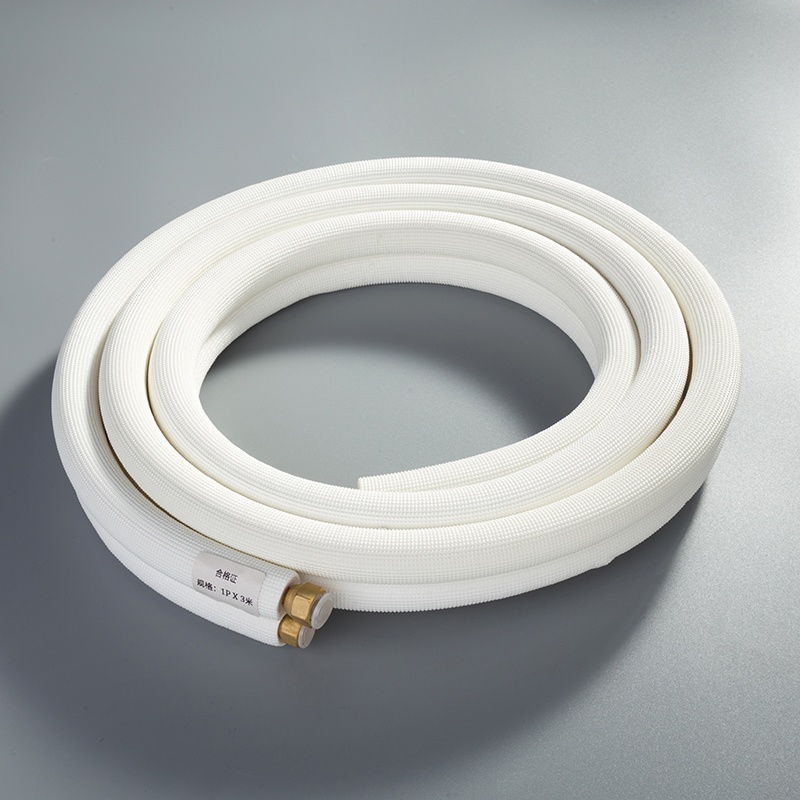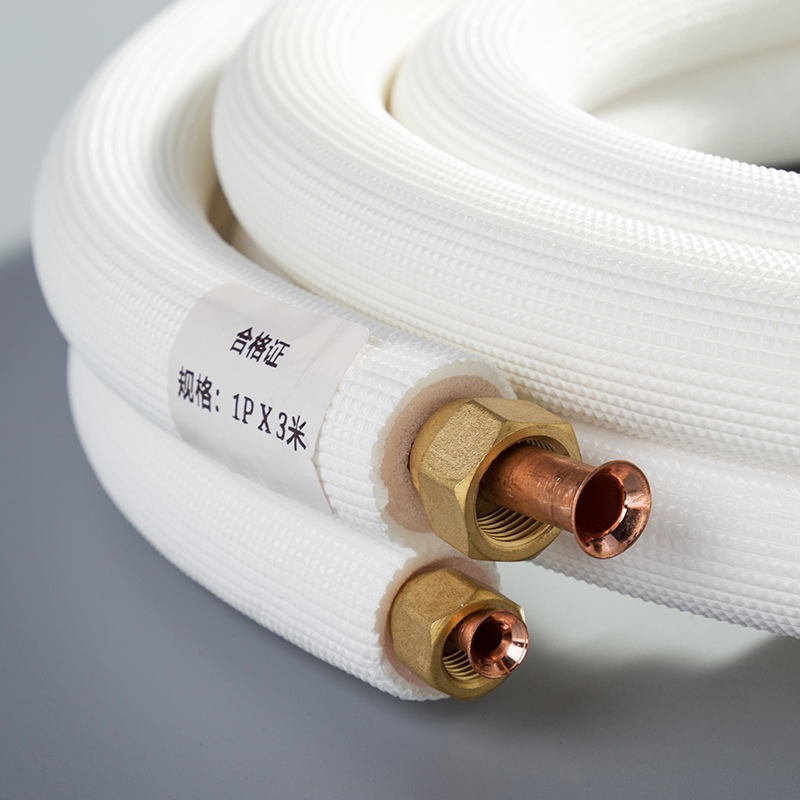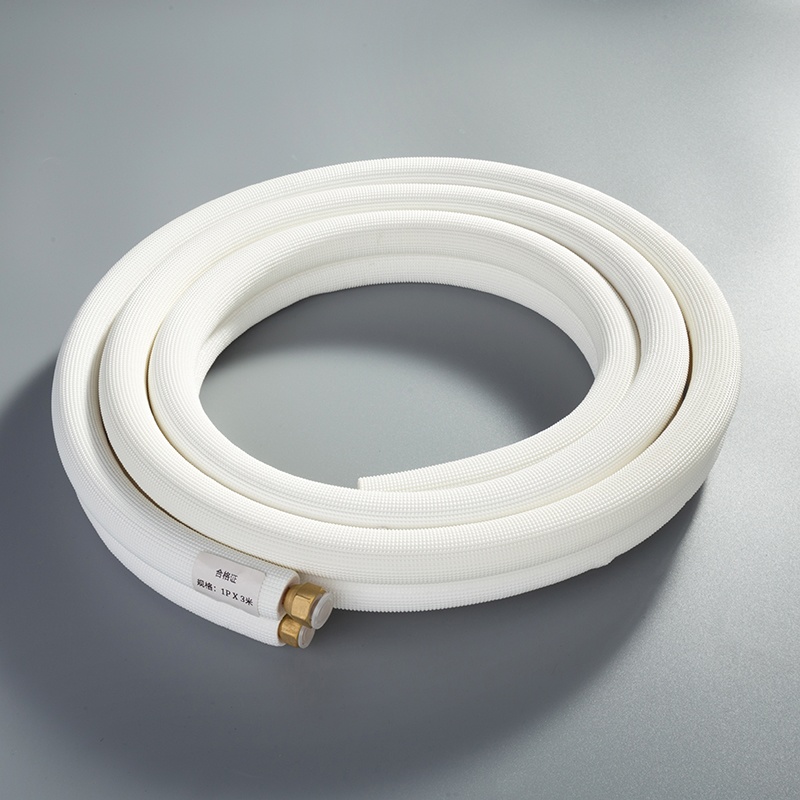Understanding the Role of Insulated Copper Pipes in Air Conditioning

Thickened insulation pressure resistant durable air conditioning link copper aluminum pipe systems are essential for ensuring the efficiency and reliability of HVAC operations. These pipes reduce heat loss and maintain consistent temperatures, significantly boosting energy efficiency. This not only decreases energy consumption but also results in substantial cost savings over time. The combination of copper's durability and aluminum's lightweight properties makes it an excellent choice for HVAC applications, as it resists corrosion and wear. The thickened insulation further enhances these advantages by preventing condensation and protecting the pipes from freezing. With improved performance and superior quality, these insulated copper aluminum pipes provide exceptional value for both residential and commercial air conditioning systems.
Key Takeaways
Insulated copper pipes significantly enhance HVAC efficiency by minimizing heat loss and maintaining consistent temperatures, leading to energy savings of up to 20%.
Proper insulation prevents condensation, protecting your property from water damage and mold growth, thus contributing to a healthier indoor environment.
In cold climates, insulated copper pipes provide freeze protection, ensuring uninterrupted HVAC performance and reducing the risk of costly pipe bursts.
Regular maintenance of insulation is crucial; inspect for damage and clean periodically to ensure optimal performance and longevity of your HVAC system.
Choosing the right insulation material is essential; consider factors like thermal resistance, durability, and moisture resistance to maximize efficiency.
Investing in insulated copper pipes not only lowers utility bills but also supports sustainable energy practices, making it a smart long-term investment for homeowners and businesses.
Why Insulated Copper Pipes Are Essential for Air Conditioning

The Role of Copper Pipes in HVAC Systems
Copper pipes play a vital role in the operation of HVAC systems. They transport refrigerants, chilled water, or heated water, ensuring efficient heat transfer throughout the system. Copper’s excellent thermal conductivity allows it to transfer heat faster than most other metals, which directly improves the performance of your air conditioning unit. This efficiency ensures that your HVAC system maintains the desired indoor temperature, whether it’s cooling during summer or heating in winter.
Additionally, copper piping is highly durable and resistant to corrosion. This durability reduces the risk of leaks or cracks, which can disrupt the system’s functionality. By using copper pipes, you ensure the longevity and reliability of your HVAC system. Their antibacterial properties also help maintain the quality of the fluids being transported, contributing to a healthier indoor environment.
How Insulation Enhances Heat Resistance and Energy Efficiency
Insulation significantly enhances the performance of copper pipes by minimizing heat loss or gain.
Proper insulation not only improves energy efficiency but also contributes to a quieter and more comfortable indoor environment.
Common Problems in HVAC Systems Without Proper Insulation
Without proper insulation, HVAC systems face several challenges that can compromise their efficiency and lifespan. Uninsulated copper pipes are prone to heat loss in winter and heat gain in summer, forcing the system to work harder to maintain the desired temperature. This increased workload leads to higher energy consumption and utility bills.
Condensation is another common issue. When warm air comes into contact with uninsulated cold pipes, moisture forms on the pipe surface. Over time, this can cause water damage to surrounding areas and promote the growth of mold or mildew. In colder climates, uninsulated pipes are at risk of freezing, which can result in pipe bursts and costly repairs.
Additionally, the lack of insulation can lead to noise issues. Vibrations and temperature changes in uninsulated copper pipes can create unwanted sounds, disrupting the comfort of your indoor space. By insulating your copper pipes, you can avoid these problems and enjoy the full benefits of an efficient and reliable HVAC system.
Key Benefits of Insulated Copper Pipes
Improved Energy Efficiency and Cost Savings
This efficiency directly translates into lower energy consumption, which can reduce your utility bills by up to 20%.
The superior thermal conductivity of copper enhances the overall performance of your system. When paired with proper insulation, it maintains the desired temperature of the fluids being transported. This combination not only ensures consistent indoor comfort but also supports sustainability goals by conserving energy. Over time, the cost savings from reduced energy usage and maintenance make insulated copper pipes a smart investment for both residential and commercial applications.
Prevention of Condensation and Water Damage
One of the most significant benefits of insulated copper pipes is the prevention of condensation. When warm air meets the cold surface of uninsulated pipes, moisture forms, leading to potential water damage. This can harm walls, ceilings, and other surrounding structures, creating costly repair needs. Insulation acts as a barrier, preventing this moisture buildup and protecting your property from damage.
In addition to structural protection, insulation helps maintain the quality of your indoor environment. By preventing condensation, it reduces the risk of mold and mildew growth, which can negatively impact air quality. This makes insulated copper pipes an essential component for maintaining a healthy and comfortable living or working space.
Freeze Protection in Cold Climates
In colder climates, uninsulated pipes are vulnerable to freezing, which can lead to pipe bursts and expensive repairs. Insulated copper pipes provide effective protection against freezing by maintaining a stable temperature within the pipes. This ensures that your HVAC systems continue to function efficiently, even during extreme weather conditions.
The durability of copper, combined with the protective layer of insulation, enhances the reliability of your system. This combination prevents the expansion and contraction that often occurs with temperature fluctuations, reducing the risk of damage. By investing in insulated copper pipes, you safeguard your system against the challenges of cold climates while ensuring uninterrupted performance.
Enhanced Cooling Performance in High-Humidity Environments
Insulated copper pipes address these challenges by maintaining consistent temperatures within the system, ensuring optimal performance even in humid conditions.
Insulation prevents external heat and moisture from affecting the copper pipes. Without insulation, warm, moist air can condense on the surface of cold pipes, leading to water buildup and potential damage. This condensation can also reduce the cooling efficiency of your system, forcing it to work harder to achieve the desired indoor temperature. Insulated pipes eliminate this issue by acting as a barrier, keeping the pipes dry and maintaining their cooling efficiency.
In high-humidity areas, insulated copper pipes also help stabilize the indoor environment. By preventing condensation, they reduce the risk of mold and mildew growth, which can compromise air quality and harm your health. This makes insulated pipes an essential component for creating a comfortable and healthy indoor space.
The benefits of insulated copper pipes extend beyond performance. They also contribute to cost savings by reducing energy consumption. When your HVAC system operates efficiently, it uses less energy to cool your home or business. This efficiency not only lowers your utility bills but also supports sustainability efforts by conserving energy. Insulated copper pipes provide a practical solution for enhancing cooling performance while delivering long-term value.
How Insulation Extends System Lifespan
Reduced Wear and Tear on HVAC Components
Insulating copper pipes reduces the strain on your HVAC system. Without insulation, temperature fluctuations force the system to work harder to maintain consistent indoor conditions. This increased effort accelerates wear and tear on critical components like compressors and fans. By maintaining stable temperatures, insulation ensures a lower workload for these parts, extending their operational lifespan.
Copper pipes, known for their excellent thermal conductivity, benefit significantly from insulation. The insulation minimizes heat transfer with the surrounding environment, allowing the system to operate efficiently. This efficiency reduces the frequency of system cycling, which often leads to mechanical stress. Over time, this protection preserves the integrity of your HVAC system, ensuring reliable performance.
Lower Risk of Corrosion and Pipe Damage
Corrosion resistance is one of the most valuable properties of copper pipes. However, exposure to moisture and temperature changes can still lead to gradual degradation. Insulation acts as a protective barrier, shielding copper pipes from environmental factors that promote corrosion. This protection ensures that your high-quality plumbing system remains intact and functional for years.
Uninsulated pipes are more vulnerable to condensation, especially in humid environments. Moisture accumulation on the pipe surface creates an ideal environment for corrosion to develop. Insulated copper pipes eliminate this risk by preventing condensation, preserving the durability and longevity of your HVAC system. Additionally, insulation protects pipes from physical damage caused by freezing or external impacts, further enhancing their reliability.
Decreased Maintenance and Repair Costs Over Time
Investing in insulated copper pipes reduces the need for frequent maintenance and costly repairs. By preventing common issues like corrosion, leaks, and freezing, insulation ensures that your HVAC system operates smoothly.
A high-quality plumbing system with insulated copper pipes also requires less routine upkeep. The insulation maintains the system’s efficiency, reducing the likelihood of unexpected breakdowns. Over time, the cost savings from decreased maintenance and repairs make insulation a practical and economical choice. You not only protect your system but also enjoy peace of mind knowing it will perform reliably for years to come.
Choosing the Right Insulation Material for Copper Pipes
Selecting the right insulation material for your copper pipes is essential to ensure optimal performance and durability for your HVAC system. The material you choose directly impacts the system's efficiency, lifespan, and ability to maintain consistent temperatures. By understanding the factors that influence insulation selection, you can make an informed decision that benefits both your home and your wallet.
Factors to Consider When Selecting Insulation
When choosing insulation for copper pipes, you should evaluate several key factors to ensure the best results:
For HVAC systems, materials with high thermal resistance help maintain consistent temperatures and reduce energy loss.
Durability: Insulation materials must withstand environmental conditions, such as moisture, temperature fluctuations, and physical wear. Durable materials prevent damage to the pipes and reduce the need for frequent replacements.
Moisture Resistance: Moisture can lead to condensation, corrosion, and mold growth. Insulation with strong moisture resistance protects your pipes and ensures a healthier indoor environment.
Ease of Installation: Some insulation materials are easier to install than others. Choosing a material that simplifies the installation process can save time and labor costs.
Cost-Effectiveness: While high-quality insulation may have a higher upfront cost, it often provides long-term savings by reducing energy consumption and maintenance expenses.
By considering these factors, you can select an insulation material that meets your specific needs and enhances the performance of your HVAC system.
Thickened Insulation Pressure Resistant Durable Air Conditioning Link Copper Aluminum Pipe
Thickened insulation pressure resistant durable air conditioning link copper aluminum pipe systems offer a reliable solution for modern HVAC applications. These systems combine the thermal conductivity of copper with the lightweight properties of aluminum, creating a highly efficient and durable option for air conditioning systems.
The thickened insulation layer plays a critical role in maintaining consistent operating temperatures. It minimizes heat transfer between the pipes and the surrounding environment, ensuring that your HVAC system operates efficiently. This insulation also prevents condensation, which can cause water damage and promote mold growth.
The pressure-resistant design of these pipes enhances their durability, making them suitable for high-performance HVAC systems. They can withstand extreme conditions, including temperature fluctuations and physical stress, without compromising their functionality. This durability reduces the risk of leaks, corrosion, and other common issues, extending the lifespan of your system.
By investing in thickened insulation pressure resistant durable air conditioning link copper aluminum pipe systems, you can enjoy improved energy efficiency, reduced maintenance costs, and a more reliable HVAC system.
Pros and Cons of Common Insulation Materials
Different insulation materials offer unique advantages and disadvantages. Understanding these can help you choose the best option for your copper pipes:
Foam Insulation:
Pros: High thermal resistance, lightweight, and easy to install.
Cons: Can degrade over time when exposed to UV light or extreme temperatures.
Rubber Insulation: Excellent moisture resistance flexibility, and durability.
Cons: Higher cost compared to other materials.
Fiberglass Insulation:
Pros: Affordable, widely available, and effective for high-temperature applications.
Cons: Requires a protective covering to prevent moisture absorption and skin irritation during installation.
Polyethylene Insulation:
Pros: Cost-effective, moisture-resistant, and easy to handle.
Cons: Limited thermal resistance compared to other materials.
Each material has its strengths and weaknesses. Foam and rubber insulation are ideal for environments with high humidity, while fiberglass works well for high-temperature systems. Polyethylene offers a budget-friendly option for basic insulation needs. By weighing these pros and cons, you can select the material that aligns with your HVAC requirements.
Best Practices for Installation and Maintenance

Proper Installation Techniques for Insulated Copper Pipes
Installing insulated copper pipes correctly is crucial for ensuring the efficiency and longevity of your HVAC system. Begin by selecting the appropriate insulation material based on your specific needs.
Before installation, clean the copper pipes thoroughly to remove dirt or grease. This step ensures the insulation adheres properly and performs effectively. Measure the length of the pipe and cut the insulation material to fit precisely. For materials like fiberglass insulation, ensure you wear protective gear to avoid irritation during handling. Wrap the insulation snugly around the pipe, ensuring there are no gaps that could allow heat loss or condensation.
Secure the insulation using adhesive strips, tape, or clamps, depending on the material. For high-performance systems, consider using polyurethane foam insulation, which provides exceptional thermal resistance and prevents air infiltration. Proper sealing at joints and bends is essential to maintain consistent insulation coverage. By following these steps, you can achieve a professional-grade installation that enhances your HVAC system's performance.
Regular Maintenance to Ensure Insulation Effectiveness
Maintaining the insulation on your copper pipes is just as important as the initial installation. Over time, wear and tear can compromise the insulation's ability to prevent heat loss or condensation. Regular inspections help you identify potential issues early, ensuring your HVAC system continues to operate efficiently.
Check for signs of damage, such as cracks, tears, or moisture buildup on the insulation surface. Materials like polyethylene foam and rubber insulation are highly resistant to moisture, but prolonged exposure to harsh conditions can still cause deterioration. Clean the insulation periodically to remove dust or debris, which can affect its performance. Use a damp cloth for cleaning and avoid harsh chemicals that might degrade the material.
If you notice any loose or detached sections, reattach them promptly using adhesive or tape. For older systems, consider upgrading to more advanced materials like mineral wool insulation, which offers superior thermal and acoustic properties. Regular maintenance not only preserves the effectiveness of the insulation but also extends the lifespan of your HVAC system.
Signs of Insulation Wear and When to Replace It
Recognizing the signs of insulation wear is essential for maintaining an efficient HVAC system. Damaged or degraded insulation can lead to energy loss, increased utility bills, and potential water damage. Look for visible cracks, tears, or discoloration on the insulation material. These issues often indicate that the insulation is no longer providing adequate protection.
Moisture buildup or condensation on the pipe surface is another common sign of wear. Materials like foam insulation and polyurethane foam are designed to resist moisture, but aging or improper installation can reduce their effectiveness. If you notice mold or mildew growth near the pipes, it’s time to replace the insulation to prevent further damage.
In colder climates, uninsulated or worn-out insulation can lead to freezing pipes. If you experience frequent pipe bursts or reduced system efficiency, consider upgrading to rubber insulation, which offers excellent freeze protection. Replacing insulation promptly ensures your HVAC system continues to perform optimally and protects your home or business from costly repairs.
Environmental and Cost Benefits of Insulated Copper Pipes
Energy Savings and Reduced Utility Bills
Insulated copper pipes provide a practical solution for achieving energy-efficient HVAC systems. By minimizing heat loss in heating systems and reducing heat gain in cooling systems, they ensure consistent temperature regulation. This efficiency reduces the workload on your HVAC system, leading to a noticeable reduction in utility bills. When your system operates efficiently, it consumes less energy, which directly translates into cost savings for homeowners and businesses.
This stability ensures that your HVAC system doesn’t overwork to maintain desired indoor conditions. Over time, this energy efficiency not only lowers your monthly expenses but also contributes to a more sustainable and environmentally friendly operation.
Contribution to Sustainable HVAC Practices
Insulated copper pipes play a vital role in promoting sustainable HVAC practices. Copper, known for its durability and longevity, combined with proper insulation, ensures that your system operates efficiently for years. This reduces the need for frequent replacements or repairs, which minimizes waste and conserves resources. The environmental benefits of using copper pipes extend beyond their durability. Their ability to maintain consistent temperatures helps reduce energy consumption, aligning with global efforts to combat climate change.
Additionally, insulation prevents condensation, which can lead to mold growth and water damage. By maintaining safety and water quality, insulated copper pipes contribute to healthier indoor environments. These pipes also support sustainability by reducing the strain on energy grids, especially during peak usage periods. Choosing insulated copper pipes reflects a commitment to environmentally responsible practices while ensuring the quality and reliability of your HVAC system.
Long-Term Cost Efficiency for Homeowners and Businesses
The long-term advantages of insulated copper pipes make them a cost-effective choice for both residential and commercial applications. Their durability ensures that they withstand wear and tear, reducing the need for frequent maintenance or replacements. This reliability translates into significant cost savings over time, as you avoid unexpected repair expenses. The combination of copper’s strength and the protective layer of insulation enhances the overall value of your HVAC system.
By choosing insulated copper pipes, you invest in a solution that delivers lasting value, safety, and efficiency for your home or business.
Insulated copper pipes are essential for creating efficient and durable HVAC systems. They improve performance by reducing energy loss, preventing condensation, and protecting against freezing. These benefits not only enhance system reliability but also lower energy costs by up to 20%. Proper insulation ensures consistent temperatures, which reduces strain on HVAC components and extends their lifespan. By selecting the right materials and following best practices for installation, you can maximize these advantages. Investing in insulated copper pipes is a smart decision for achieving long-term savings and promoting sustainable energy use in homes and businesses.
FAQ
What are insulated copper pipes, and why are they important?
Insulated copper pipes are copper tubes covered with a protective layer of insulation material. These pipes play a critical role in HVAC systems by maintaining consistent temperatures for refrigerants or water. The insulation prevents heat loss or gain, ensuring energy efficiency and optimal system performance. By using insulated copper pipes, you protect your HVAC system from moisture-related damage, freezing, and unnecessary wear.
How do insulated copper pipes improve energy efficiency?
Insulated copper pipes reduce heat transfer between the pipe and its surroundings. This minimizes energy loss in heating systems and prevents heat gain in cooling systems. As a result, your HVAC system operates more efficiently, consuming less energy. This efficiency not only lowers utility bills but also reduces the environmental impact of your system.
"Insulating copper pipes is one of the simplest, yet most powerful ways to enhance energy efficiency and improve HVAC performance."
Can insulated copper pipes prevent condensation?
Yes, insulated copper pipes effectively prevent condensation. When warm air meets the cold surface of uninsulated pipes, moisture forms, leading to potential water damage and mold growth. Insulation acts as a barrier, keeping the pipe surface dry and protecting your property from these issues. This makes insulated pipes essential for maintaining a healthy indoor environment.
Are insulated copper pipes suitable for cold climates?
Absolutely. Insulated copper pipes provide excellent freeze protection in cold climates. The insulation maintains a stable temperature within the pipes, preventing freezing and the risk of pipe bursts. This ensures that your HVAC system continues to function efficiently, even during extreme weather conditions.
What types of insulation materials are commonly used for copper pipes?
Several insulation materials are suitable for copper pipes, including:
Foam insulation: Lightweight and easy to install, with high thermal resistance.
Rubber insulation: Flexible, durable, and excellent for moisture resistance.
Fiberglass insulation: Affordable and effective for high-temperature applications.
Polyethylene insulation: Cost-effective and moisture-resistant, ideal for basic needs.
Each material has unique benefits, so selecting the right one depends on your specific requirements.
How does insulation extend the lifespan of copper pipes?
Insulation protects copper pipes from external factors like moisture, temperature fluctuations, and physical damage. This reduces the risk of corrosion, freezing, and wear. By minimizing these risks, insulation ensures that your pipes remain durable and functional for years, reducing the need for frequent repairs or replacements.
What maintenance do insulated copper pipes require?
Regular maintenance involves inspecting the insulation for cracks, tears, or moisture buildup. Cleaning the insulation surface and reattaching any loose sections helps maintain its effectiveness. If you notice significant wear or damage, replacing the insulation promptly ensures continued protection and efficiency for your HVAC system.
How do insulated copper pipes contribute to sustainability?
Insulated copper pipes support sustainable HVAC practices by reducing energy consumption and minimizing waste. Copper’s durability ensures long-lasting performance, while insulation enhances efficiency. This combination lowers your carbon footprint and aligns with global efforts to conserve energy and combat climate change.
Are insulated copper pipes cost-effective?
Yes, insulated copper pipes offer long-term cost savings. They reduce energy consumption, lowering utility bills by up to 20%. Additionally, they minimize maintenance and repair costs by protecting the pipes from damage. Over time, the initial investment in insulated copper pipes pays off through reduced expenses and improved system reliability.
How can I ensure proper installation of insulated copper pipes?
Proper installation starts with selecting the right insulation material for your needs. Clean the pipes thoroughly before applying the insulation to ensure a secure fit. Use adhesive strips, tape, or clamps to secure the insulation and seal all joints and bends. Following these steps ensures professional-grade installation and maximizes the benefits of insulated copper pipes.
See Also
The Benefits Of Using Copper Pipes In AC Systems
The Importance Of Pure Copper Pipes For AC Efficiency
How Copper Pipes Transform The Air Conditioning Experience


